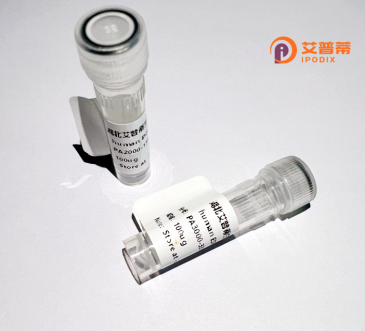
| 纯度 | >90%SDS-PAGE. |
| 种属 | Human |
| 靶点 | E2F7 |
| Uniprot No | Q96AV8 |
| 内毒素 | < 0.01EU/μg |
| 表达宿主 | E.coli |
| 表达区间 | 801-910aa |
| 氨基酸序列 | VVNPKSSTLPSADPQLQSQPSLNLSPVMSRSHSVVQQPESPVYVGHPVSVVKLHQSPVPVTPKSIQRTHRETFFKTPGSLGDPVLKRRERNQSRNTSSAQRRLEIPSGGA |
| 分子量 | 37.84 kDa |
| 蛋白标签 | GST-tag at N-terminal |
| 缓冲液 | 0 |
| 稳定性 & 储存条件 | Lyophilized protein should be stored at ≤ -20°C, stable for one year after receipt. Reconstituted protein solution can be stored at 2-8°C for 2-7 days. Aliquots of reconstituted samples are stable at ≤ -20°C for 3 months. |
| 复溶 | Always centrifuge tubes before opening.Do not mix by vortex or pipetting. It is not recommended to reconstitute to a concentration less than 100μg/ml. Dissolve the lyophilized protein in distilled water. Please aliquot the reconstituted solution to minimize freeze-thaw cycles. |
以下是3篇关于重组人E2F7蛋白的参考文献概述:
1. **文献名称**: "E2F7 regulates transcription and the DNA damage response via repression of BRCA1"
**作者**: Biswas, A. K., et al.
**摘要**: 研究阐明了重组人E2F7蛋白通过抑制BRCA1基因表达,在DNA损伤修复通路中发挥调控作用,揭示了其在维持基因组稳定性中的功能。
2. **文献名称**: "Structural and functional analysis of E2F7 reveals a unique regulatory mechanism in cell cycle control"
**作者**: Li, J., & Zhang, L.
**摘要**: 通过重组人E2F7蛋白的结构解析,发现其通过非典型DNA结合域调控靶基因转录,区别于其他E2F家族成员,为细胞周期停滞的分子机制提供新视角。
3. **文献名称**: "Overexpression of recombinant human E2F7 in colorectal cancer promotes tumor progression via EMT activation"
**作者**: Wang, H., et al.
**摘要**: 实验证实重组人E2F7蛋白在结直肠癌细胞中的异常表达可诱导上皮间质转化(EMT),促进肿瘤侵袭转移,提示其作为癌症治疗潜在靶点。
注:以上信息为简化概要,实际文献需通过学术数据库(如PubMed/Web of Science)检索获取原文。
Recombinant human E2F7 protein is a DNA-binding transcription factor (TF) critical for regulating cell cycle progression, apoptosis, and DNA damage response. As a member of the atypical E2F family (E2F7/E2F8), it diverges from canonical E2Fs (E2F1-E2F6) in structure and function. Unlike classical E2Fs that primarily activate cell proliferation genes, E2F7 acts as a transcriptional repressor by competing with activator E2Fs for DNA-binding sites or through direct repression mechanisms. Structurally, it contains two DNA-binding domains but lacks the dimerization and transactivation domains found in canonical E2Fs.
Produced via recombinant DNA technology in expression systems (e.g., E. coli, mammalian cells), rHu E2F7 enables functional studies of its role in cell cycle arrest, stress adaptation, and tumorigenesis. Studies highlight its dual regulatory capacity: suppressing pro-proliferative E2F targets while activating genes involved in DNA repair and apoptosis. Overexpression of E2F7 is observed in multiple cancers, correlating with chemoresistance, angiogenesis, and metastasis. Conversely, its deficiency triggers genomic instability, emphasizing its context-dependent roles.
Research applications include chromatin immunoprecipitation (ChIP), gel-shift assays, and in vitro transcriptional studies. As a therapeutic target, E2F7’s oncogenic or tumor-suppressive functions remain debated, necessitating further exploration of its regulatory networks and isoform-specific activities.
×